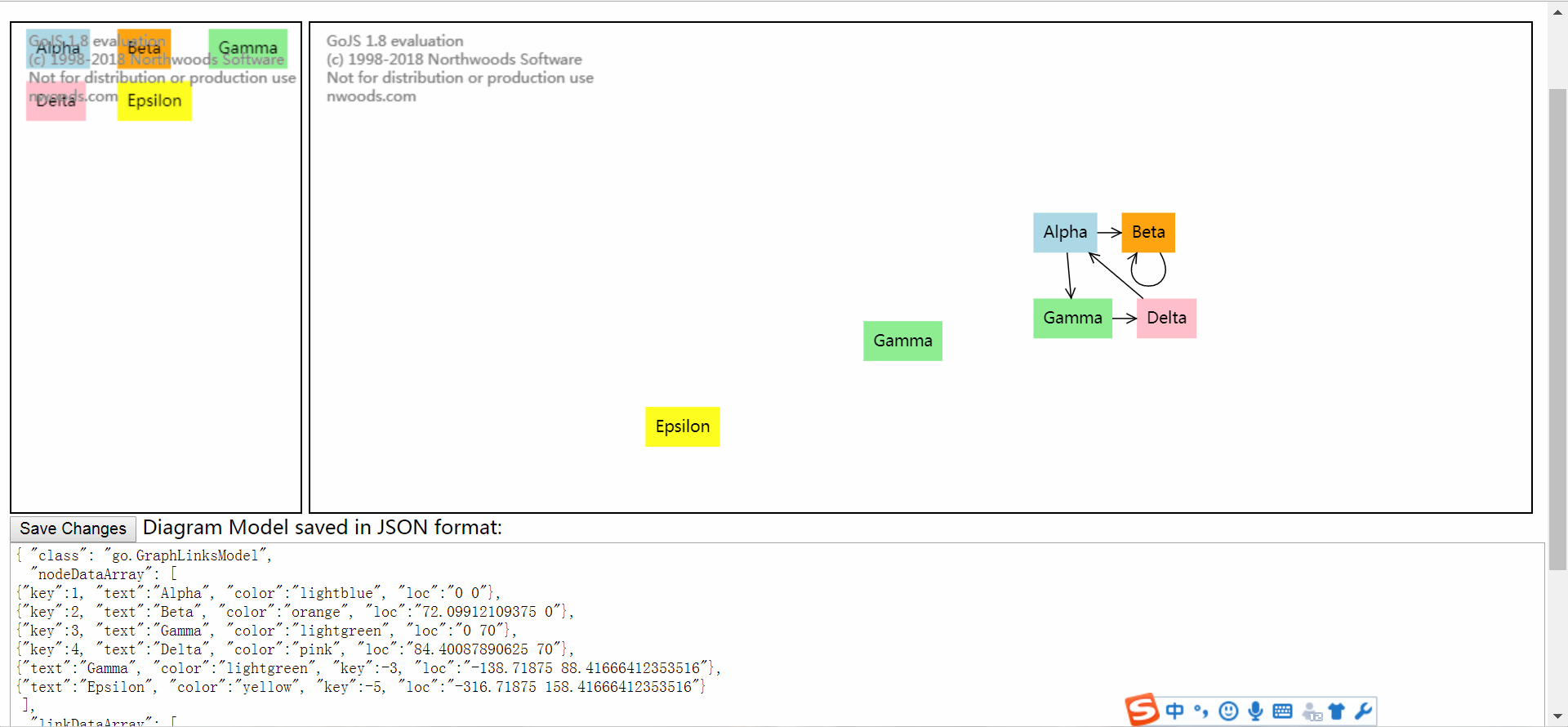GoJS是一个实现交互类图表(比如流程图,树图,关系图,力导图等等)的JS库
gojs提供了angular的基本例子,不过是离线版
https://github.com/NorthwoodsSoftware/GoJS/tree/master/projects/angular-basic
下图是运行结果。上面是可拖动的,下面显示当前图表的结构

一。首先完成上面可拖动的部分
diagram-editor
diagram-editor.component.ts
constructor中完成初始化图表的基本属性如颜色等
this.getModel();从服务器获得列表
this.networkService.getModelText().then(r => { console.log(r); this.createModel(JSON.stringify(r)); });
r => { } r是获得的数据,括号里面可以添加对数据进行的操作(可以加函数),我获取数据就是完整的json格式的gojs图表,直接string化传给model它就可以识别了,图表格式如下
{ "class": "go.GraphLinksModel",
"nodeDataArray": [
{"key":1, "text":"Alpha", "color":"lightblue", "loc":"0 0"},
{"key":2, "text":"Beta", "color":"orange", "loc":"72.09912109375 0"},
{"key":3, "text":"Gamma", "color":"lightgreen", "loc":"0 70"},
{"key":4, "text":"Delta", "color":"pink", "loc":"84.40087890625 70"},
{"text":"Gamma", "color":"lightgreen", "key":-3, "loc":"-138.71875 88.41666412353516"},
{"text":"Epsilon", "color":"yellow", "key":-5, "loc":"-316.71875 158.41666412353516"}
],
"linkDataArray": [
{"from":1, "to":2},
{"from":1, "to":3},
{"from":2, "to":2},
{"from":3, "to":4},
{"from":4, "to":1}
]}
然后调用函数createModel,用gojs自带函数go.Model.fromJson显示表格,这样可以实现异步加载图表。
onSave()保存图表到服务器
import { Component, OnInit, ViewChild, ElementRef, Input, Output, EventEmitter, AfterContentInit } from '@angular/core'; import * as go from 'gojs'; import { NetworkService } from '../network.service'; import { Observable } from 'rxjs/observable'; import { catchError, map, tap } from 'rxjs/operators'; import { interval } from 'rxjs/observable/interval'; import {passBoolean} from 'protractor/built/util'; @Component({ selector: 'app-diagram-editor', templateUrl: './diagram-editor.component.html', styleUrls: ['./diagram-editor.component.css'] }) export class DiagramEditorComponent implements OnInit { private diagram: go.Diagram = new go.Diagram(); private palette: go.Palette = new go.Palette(); @ViewChild('diagramDiv') private diagramRef: ElementRef; @ViewChild('paletteDiv') private paletteRef: ElementRef; @Input() get model(): go.Model { return this.diagram.model; } set model(val: go.Model) { this.diagram.model = val; } @Output() nodeSelected = new EventEmitter<go.Node|null>(); @Output() modelChanged = new EventEmitter<go.ChangedEvent>(); constructor(private networkService: NetworkService) { this.getModel(); const $ = go.GraphObject.make; this.diagram = new go.Diagram(); this.diagram.initialContentAlignment = go.Spot.Center; this.diagram.allowDrop = true; // necessary for dragging from Palette this.diagram.undoManager.isEnabled = true; this.diagram.addDiagramListener("ChangedSelection", e => { const node = e.diagram.selection.first(); this.nodeSelected.emit(node instanceof go.Node ? node : null); }); this.diagram.addModelChangedListener(e => e.isTransactionFinished && this.modelChanged.emit(e)); this.diagram.nodeTemplate = $(go.Node, "Auto", new go.Binding("location", "loc", go.Point.parse).makeTwoWay(go.Point.stringify), $(go.Shape, { fill: "white", strokeWidth: 0, portId: "", cursor: "pointer", // allow many kinds of links fromLinkable: true, toLinkable: true, fromLinkableSelfNode: true, toLinkableSelfNode: true, fromLinkableDuplicates: true, toLinkableDuplicates: true }, new go.Binding("fill", "color")), $(go.TextBlock, { margin: 8, editable: true }, new go.Binding("text").makeTwoWay()) ); this.diagram.linkTemplate = $(go.Link, // allow relinking { relinkableFrom: true, relinkableTo: true }, $(go.Shape), $(go.Shape, { toArrow: "OpenTriangle" }) ); this.palette = new go.Palette(); this.palette.nodeTemplateMap = this.diagram.nodeTemplateMap; // initialize contents of Palette this.palette.model.nodeDataArray = [ { text: "Alpha", color: "lightblue" }, { text: "Beta", color: "orange" }, { text: "Gamma", color: "lightgreen" }, { text: "Delta", color: "pink" }, { text: "Epsilon", color: "yellow" } ]; } ngOnInit() { this.diagram.div = this.diagramRef.nativeElement; this.palette.div = this.paletteRef.nativeElement; } getModel(): void { this.networkService.getModelText().then(r => { console.log(r); this.createModel(JSON.stringify(r)); }); } createModel(a: string ): void { this.model = go.Model.fromJson(a); } onSave(): void { this.networkService.saveModel(this.diagram.model.toJson()).subscribe(); } }
diagram-editor.component.html
<div class="diagramsPanel"> <div #paletteDiv class="paletteDiv"></div> <div #diagramDiv class="diagramDiv"></div> <div> <button (click)="onSave()">Save Changes</button> Diagram Model saved in JSON format: </div> <div> <textarea *ngIf="model" style="width:100%;height:300px"> {{model.toJson()}} </textarea> </div> </div>
二。下半部分显示json字符串:
import { Component, OnInit, ViewChild, ElementRef, Input, Output, EventEmitter } from '@angular/core'; import * as go from 'gojs'; @Component({ selector: 'app-diagram-detail', templateUrl: './diagram-detail.component.html', styleUrls: ['./diagram-detail.component.css'] }) export class DiagramDetailComponent implements OnInit { @Input() node: go.Node; @Input() data: any; constructor() { } ngOnInit() { } showDetails(node: go.Node | null) { this.node = node; if (node) { // copy the editable properties into a separate Object this.data = { text: node.data.text, color: node.data.color }; } else { this.data = null; } } }
diagram-detail.component.html
<div *ngIf="node"> <form *ngIf="node" #form="ngForm" (ngSubmit)="onCommitDetails()"> Node Details: <div><label>Key: </label>{{node.key}}</div> <div><label>Text: </label><input [(ngModel)]="data.text" name="text"></div> <div><label>Color: </label><input [(ngModel)]="data.color" name="color"></div> <div><label>Location: </label>{{node.location.x.toFixed(2)}}, {{node.location.y.toFixed(2)}}</div> <div><label># Links: </label>{{node.linksConnected.count}}</div> </form> </div>
三。与服务器通信,用了promise,可以实现异步传输,使用rxjs库需要具体说明路径,有部分冗余代码,不懂得可以看看angular官方文档http部分
network.service.ts
import { Injectable } from '@angular/core'; import { Observable } from 'rxjs/Observable'; import { HttpClient, HttpHeaders, HttpClientModule } from '@angular/common/http'; import { of } from 'rxjs/observable/of'; import { catchError, map, tap , retry } from 'rxjs/operators'; import 'rxjs/add/operator/toPromise'; import { MessageService } from './message.service'; import {promise} from 'selenium-webdriver'; const httpOptions = { //headers: new HttpHeaders({ 'Content-Type': 'application/json' }) headers: new HttpHeaders({'Content-Type': 'application/x-www-form-urlencoded'}) }; @Injectable() export class NetworkService { public API = '//localhost:8888'; private getModelUrl = this.API + '/gojs/get'; // URL to web api private saveModelUrl = this.API + '/gojs/save'; constructor(private http: HttpClient, private messageService: MessageService) { } // getModel(): Observable<string> { // const url = `${this.getModelUrl}`; // return this.http.get<string>(url).pipe( // catchError(this.handleError<string>(`getModel`)) // ); // } /** GET: get the model on the server */ getModelText(): Promise<any> { // The Observable returned by get() is of type Observable<string> // because a text response was specified. // There's no need to pass a <string> type parameter to get(). return this.http.get(this.getModelUrl).toPromise().catch(this.handleError()); } /** PUT: update the model on the server */ saveModel (data: string): Observable<any> { // return this.http.post(this.saveModelUrl, data, httpOptions).pipe( // catchError(this.handleError<any>('saveModel')) // ); const body = {model: data}; this.http.post(this.saveModelUrl, 'model=' + data, httpOptions).subscribe(model => { console.log(data); }); return null; } /** * Handle Http operation that failed. * Let the app continue. * @param operation - name of the operation that failed * @param result - optional value to return as the observable result */ private handleError<T> (operation = 'operation', result?: T) { return (error: any): Observable<T> => { // TODO: send the error to remote logging infrastructure console.error(error); // log to console instead // TODO: better job of transforming error for user consumption this.log(`${operation} failed: ${error.message}`); // Let the app keep running by returning an empty result. return of(result as T); }; } /** Log a HeroService message with the MessageService */ private log(message: string) { this.messageService.add('NetworkService: ' + message); } }
message.service.ts没什么大用
import { Injectable } from '@angular/core'; @Injectable() export class MessageService { messages: string[] = []; add(message: string) { this.messages.push(message); } clear() { this.messages = []; } }
服务器和angular位于不同端口,添加以下代码,否则不允许访问,这里用的服务器是springboot,服务器就比较简单了,不再细说
import org.springframework.context.annotation.Configuration; import org.springframework.web.servlet.config.annotation.CorsRegistry; import org.springframework.web.servlet.config.annotation.WebMvcConfigurerAdapter; @Configuration public class CorsConfig extends WebMvcConfigurerAdapter { @Override public void addCorsMappings(CorsRegistry registry) { registry.addMapping("/**") .allowedOrigins("*") .allowCredentials(true) .allowedMethods("GET", "POST", "DELETE", "PUT") .maxAge(3600); } }